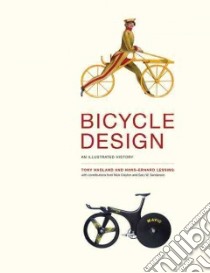Bicycle Design - 9780262026758
Un libro in lingua di Tony Hadland Hans-erhard Lessing Clayton Nick (CON) Sanderson Gary W. (CON) edito da Mit Pr, 2014
- € 32.90
- Il prezzo è variabile in funzione del cambio della valuta d’origine
The bicycle ranks as one of the most enduring, most widely used vehicles in theworld, with more than a billion produced during almost two hundred years of cycling history. Thisbook offers an authoritative and comprehensive account of the bicycle's technical and historicalevolution, from the earliest velocipedes (invented to fill the need for horseless transport during ashortage of oats) to modern racing bikes, mountain bikes, and recumbents. It traces the bicycle'sdevelopment in terms of materials, ergonomics, and vehicle physics, as carried out by inventors,entrepreneurs, and manufacturers.
Written by two leading bicycle historians andgenerously illustrated with historic drawings, designs, and photographs, BicycleDesign describes the key stages in the evolution of the bicycle, beginning with thecounterintuitive idea of balancing on two wheels in line, through the development of tension-spokedwheels, indirect drives (employing levers, pulleys, chains, and chainwheels), and pneumatic tires.The authors examine the further development of the bicycle for such specific purposes as racing,portability, and all-terrain use; and they describe the evolution of bicycle components includingseats, transmission, brakes, lights (at first candle-based), and carriers (racks, panniers,saddlebags, child seats, and sidecars). They consider not only commercially successful designs butalso commercial failures that pointed the way to future technological developments. And they debunksome myths about bicycles -- for example, the mistaken but often-cited idea that Leonardo sketched achain-drive bike in his notebooks. Despite the bicycle's long history and mass appeal, itstechnological history has been neglected. This volume, with its engaging and wide-ranging coverage,fills that gap. It will be the starting point for all future histories of the bicycle.
Informazioni bibliografiche
- Titolo del Libro in lingua: Bicycle Design
- Sottotitolo: An Illustrated History
- Lingua: English
- Autori : Tony Hadland Hans-erhard Lessing Clayton Nick (CON) Sanderson Gary W. (CON)
- Editore: Mit Pr
- Collana: Mit Pr (Hardcover)
- Data di Pubblicazione: 21 Marzo '14
- Genere: TRANSPORTATION
- Argomenti : Bicycles Design and construction History Bicycles Parts History
- Pagine: 564
- Dimensioni mm: 228 x 177 x 0
- EAN-13: 9780262026758


